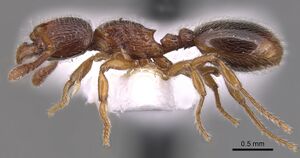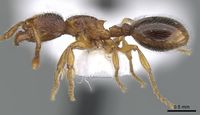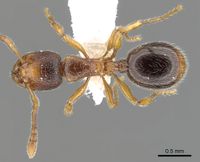Myrmecina melonii
| Myrmecina melonii | |
|---|---|

| |
| Scientific classification | |
| Kingdom: | Animalia |
| Phylum: | Arthropoda |
| Class: | Insecta |
| Order: | Hymenoptera |
| Family: | Formicidae |
| Subfamily: | Myrmicinae |
| Tribe: | Crematogastrini |
| Genus: | Myrmecina |
| Species: | M. melonii |
| Binomial name | |
| Myrmecina melonii Rigato, 1999 | |
Rigato (1999) Meloni pers. comm.: In both localities the specimens were collected under stones in scattered Mediterranean scrub (oleo-ceratonion plant association). The dates of collection might indicate that this ant move down into the ground during the warmer months, when it has been searched for, but never collected.
Identification
Rigato (1999) - Similar to Myrmecina sicula and Myrmecina atlantis in reddish colour and shape of the scape. It may be separated from both by the sculpture, composed of longitudinal rugulae, weakly developed on the alitrunk, superimposed on a faint ground reticulation, and by the short propodeal spines (Figs. 3-4). In Myrmecina sicula the alitrunk is mostly smooth, contrasting with the matte head; in Myrmecina atlantis head and alitrunk have strong rugulae with more developed ground reticulation.
Keys including this Species
Distribution
Latitudinal Distribution Pattern
Latitudinal Range: 39.016667° to 39.016667°.
| North Temperate |
North Subtropical |
Tropical | South Subtropical |
South Temperate |
- Source: AntMaps
Distribution based on Regional Taxon Lists
Palaearctic Region: Italy (type locality).
Distribution based on AntMaps
Distribution based on AntWeb specimens
Check data from AntWeb
Countries Occupied
| Number of countries occupied by this species based on AntWiki Regional Taxon Lists. In general, fewer countries occupied indicates a narrower range, while more countries indicates a more widespread species. |

|
Estimated Abundance
| Relative abundance based on number of AntMaps records per species (this species within the purple bar). Fewer records (to the left) indicates a less abundant/encountered species while more records (to the right) indicates more abundant/encountered species. |

|
Biology
Castes
Worker
Images from AntWeb
   
| |
| Holotype of Myrmecina melonii. Worker. Specimen code casent0904563. Photographer Will Ericson, uploaded by California Academy of Sciences. | Owned by MSNM, Milano, Italy. |
Nomenclature
The following information is derived from Barry Bolton's Online Catalogue of the Ants of the World.
- melonii. Myrmecina melonii Rigato, 1999: 84, figs. 1, 3, 4, 8 (w.) ITALY.
Unless otherwise noted the text for the remainder of this section is reported from the publication that includes the original description.
Description
Worker
Holotype: TL 3.2, HW 0.71, HLO.72, CI 99, SLO.64, SI 90, PW 0.48, AL 0.87. Mandibles distally chiefly smooth with a faint irregular sculpture, basally with some longitudinal rugae and feebly reticulated in the interrugal space. Dentition as in the other taxa examined, i.e. 10 irregular teeth arranged as follows; apical tooth strong, followed by a blunt preapical denticle and a third better developed tooth. The latter is followed by a series of 7 small blunt teeth regularly arranged on the proximal, convex portion of the masticatory margin, the largest tooth of this series is the penultimate, which is followed by a denticle marking the angle between the basal and masticatory margin. Palp formula 4,3. Clypeus smooth with a faint, median incomplete longitudinal keel and the medial raised portion bearing three blunt processes on its front edge. Frontal area slightly impressed and very ill-defined. Head dorsum with longitudinal irregular rugulae diverging posteriad. Spaces between the rugulae finely and superficially reticulate, nearly smooth. Middle oblong area on the front plus sides of the head below the eyes devoid of sculpture except for a very faint, fine reticulum. Frontal lobes long, widely separated and diverging posteriorly. Scape cylindrical and regularly bent near its base. Ventral surface of the head with slightly anteriorly and strongly midward directed parallel rugulae. Compound eye smaiL with about 12 ommatidia, those forming the marginal ring often incomplete. Alitrunk in dorsal view longitudinally irregularly rugulose: the rugulae faint and interrupted in the centre of the pronotum, stronger on the mesonotum. Anteriorly, towards the neck the rugulae arch rightward. Finely reticulate ground sculpture recognizable only on the margin of the dorsum and especially on the propodeum: the latter has a mid-dorsal, short, longitudinal carina. Anteropropodeal processes absent from the profile. Propodeal faces separate by a ridge which joins the spines, which are short and dentiform in profile. Declivitous propodeal face smooth. Sides of the alitrunk longitudinally and irregularly rugose with faint ground reticulation. Petiole with a smooth, margined, anterior face. The rest of it and the postpetiole with some short coarse longitudinal rugulae and feeble ground sculpture. Postpetiole with a nearly smooth dorsum. Gaster smooth and shining, very superficially, but regularly reticulate. Legs smooth: scape with few longitudinal rugulae and distinct hair pits. Hairs abundant on the body and appendages. They are mostly decumbent on the latters and on the head and gaster; more raised on the alitrunk with long erect humeral setae. On the head there are a few pairs of long setae on the frontal lobes and the lateral margination of the mid-portion of the clypeus. Pubescence absent. Main colour bright ferrugineous; posterior half of the cephalic dorsum darker; first segment of the gaster brown, with a reddish tinge.
Paratype: TL 2.9-3.5, HW 0.64-0.76, HL 0.67-0.77, CI 95-100, SL 0.60-0.68, Sl 87-96, PW 0.43-0.55, AL 0.75-0.92 (33 measured). Very similar to the holotype with the following main variations: the alitrunk sculpture appearing either fainter or stronger especially on the pronotum where rugulae may even be complete. Propodeal spines reduced to very blunt teeth in the series from Santiidi (Fig. 4). The colour appears rather constant except for few specimens with dorsum of the alitrunk dark reddish and a single one which is very close to a pale Myrmecina graminicola in tinge.
Type Material
Holotype worker: Italy, Sardegna. Cagliari, Isola di Sant'Antioco, locality Perdas de Fogu, 180-200 m a.s.l.. 3-TI-90 legit C. Meloni (Museo Civico di Storia Naturale, Milano). Paratypes: 17 workers with the same data of the holotype; 16 workers: ITALY, Sardegna, Cagliari, Santadi, Ponte Isca, 60-70 m a.s.l., 30-1-1994 legit C. Meloni (The Natural History Museum; CMPC; FRPC; Institute of Zoology, Ukrainian Academy of Science; Museo Civico di Storia Naturale, Genoa; Museo Civico di Storia Naturale, Milano; MMPC; Museum of Comparative Zoology; Musee National d'Histoire Naturelle; Naturhistorisches Museum, Basel).
References
- Rigato, F. 1999. Myrmecina melonii n. sp., a new ant from Sardinia, with a review of the West Palaearctic Myrmecina (Hymenoptera Formicidae). Boll. Soc. Entomol. Ital. 131: 83-92.
- Borowiec, L. 2014. Catalogue of ants of Europe, the Mediterranean Basin and adjacent regions (Hymenoptera: Formicidae). Genus (Wroclaw) 25(1-2): 1-340.
- Schifani, E. (2022). The new checklist of the Italian fauna: Formicidae. Biogeographia – The Journal of Integrative Biogeography 37, ucl006 (doi:10.21426/b637155803).
- Schifani, E., Nalini, E., Gentile, V., Alamanni, F., Ancona, C., Caria, M., Cillo, D., Bazzato, E. 2021. Ants of Sardinia: An updated checklist based on new faunistic, morphological and biogeographical notes. Redia 104, 21–35 (doi:10.19263/redia-104.21.03).
- Schifani, E., Scupola, A., Alicata, A. 2020. Morphology, ecology and biogeography of Myrmecina sicula André, 1882, rediscovered after 140 years (Hymenoptera, Formicidae). Biogeographia – The Journal of Integrative Biogeography 35, 105–116 (doi:10.21426/b635048444).
References based on Global Ant Biodiversity Informatics
- Okido H. 2011. Biogeography of the ant genus Myrmecina from Asia (Hymenoptera; Formicidae). Kankyo Kanri 40: 60-64.
- Rigato, F. "Myrmecina melonii n. sp. a new ant from Sardinia, with a review of the West Paleartic Myrmecina." Bollettino della Società Entomologica Italiana 131 (1) (1999): 83-92.

